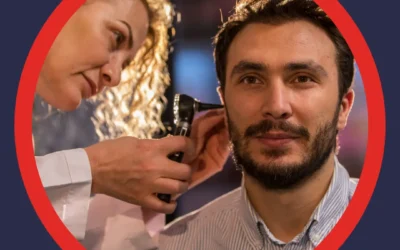Imagine sitting in a busy café where the hum of chatter blurs into a wall of sound. You strain to follow the person across from you, but their words keep slipping away. Or picture crossing a street without knowing which direction traffic is coming from. These disorienting moments are common for people with bilateral hearing loss.
According to a NORC study, nearly 38 million Americans live with hearing loss in both ears. The condition becomes especially common after age 60, but it affects people at all stages of life. While many dismiss the early signs as “mumbling” or selective hearing, recognizing the problem early makes treatment far more effective.
Addressing hearing issues in both ears matters because your brain relies on balanced input to localize sound, understand speech in noisy environments, and stay connected to the world around you. When both ears are compromised, these everyday tasks become harder than they need to be.
The next step in understanding this condition is learning what sets it apart from other types of hearing loss.

What Is Bilateral Hearing Loss?
Bilateral hearing loss means both ears are affected, unlike unilateral hearing loss, which impacts only one. The loss may be symmetrical, with equal severity in both ears, or asymmetrical, with one ear performing better than the other.
This condition can develop slowly, often going unnoticed until communication becomes frustrating. In other cases, it appears suddenly, such as after illness or injury. Regardless of how it begins, hearing loss in both ears affects how well you process sound and stay engaged with daily life.
Acknowledging the problem early helps protect long-term hearing health. Learn more in Acknowledging the Reality of Hearing Loss.
Common Symptoms You Shouldn’t Ignore
The most recognizable sign of bilateral hearing loss is difficulty understanding speech. But the symptoms often show up in small, everyday frustrations before they become impossible to ignore.
Everyday Clues of Hearing Trouble
You may notice one or more of these issues creeping into your routine:
- Muffled or distorted speech: Voices sound unclear, as if people are mumbling.
- Background noise challenges: Conversations in restaurants, busy stores, or cafés feel overwhelming.
- Constant repeats: You ask friends or coworkers to repeat themselves often.
- TV and phone volume battles: You keep turning up the sound while others complain it’s too loud.
- Fatigue from listening: You feel drained after social events because of the effort it takes to hear.
- Lipreading reliance: You find yourself watching people’s mouths more than listening to their words.
- Trouble with children’s or higher voices: Higher-pitched sounds seem faint or unclear.
- Difficulty in group conversations: Following more than one speaker at a time feels impossible.
- Ringing or buzzing in both ears: Tinnitus may develop alongside hearing loss.
- Misunderstanding directions or warnings: You miss important cues in public places, like announcements at airports or stations.
How It Can Affect Daily Life
Hearing loss in both ears doesn’t just reduce sound—it changes how you interact with the world. Locating where sounds come from becomes harder, making situations like crossing a busy street or responding to a ringing phone more stressful. Social situations may also feel frustrating, leading some people to withdraw rather than struggle through conversations.
Recognizing these signs early makes a big difference in long-term outcomes. Research even links untreated hearing loss to cognitive decline. Learn more about that connection in Why You Should Schedule a Hearing Test This World Alzheimer’s Month.
Next, let’s look at the different degrees of bilateral hearing loss and what they mean for daily life.
Degrees of Bilateral Hearing Loss
Not all bilateral hearing loss is the same. Audiologists classify it by severity, measured in decibels (dB). The degree of loss, along with whether it is symmetrical or asymmetrical, shapes how daily life is affected.
Degrees of Hearing Loss and Daily Impact
|
Degree of Hearing Loss |
Decibel (dB) Range* |
Hearing Ability |
Real-World Impact |
|
Mild |
26–40 dB |
Can hear most speech but misses soft sounds or distant voices |
Struggles with whispers, children’s voices, or conversations in noisy rooms |
|
Moderate |
41–55 dB |
Speech at normal volume is unclear |
Frequently asks for repeats; hard to follow group conversations |
|
Moderately Severe |
56–70 dB |
Only hears loud speech when close |
Misses doorbells, phone rings, and parts of everyday conversations |
|
Severe |
71–90 dB |
Cannot hear normal speech |
Misses even loud sounds like alarms; communication relies on aids or lipreading |
|
Profound |
91+ dB |
Very limited hearing ability |
Relies almost entirely on visual cues, hearing aids, or implants |
*Measured during a hearing test across multiple speech frequencies.
Symmetrical vs. Asymmetrical Hearing Loss
|
Type |
What It Means |
Daily Impact |
|
Symmetrical |
Both ears affected equally |
Consistent hearing loss across both ears; harder to notice at first |
|
Asymmetrical |
One ear worse than the other |
Sound seems “lopsided”; harder to localize voices or traffic direction |
Knowing whether your loss is symmetrical or asymmetrical helps audiologists program hearing aids more precisely.
Understanding your degree of loss is the first step toward personalized treatment.

Types of Bilateral Hearing Loss
Audiologists classify bilateral hearing loss into three main types. Each affects the ear differently and requires tailored treatment.
Comparison of Hearing Loss Types
|
Type |
Where the Problem Occurs |
Common Causes |
Typical Treatment |
|
Sensorineural |
Inner ear or auditory nerve |
Aging (presbycusis), noise exposure, genetics, ototoxic medications |
Hearing aids, cochlear implants, auditory rehabilitation |
|
Conductive |
Outer or middle ear |
Earwax buildup, infections, eardrum perforation, structural malformations |
Medical treatment, earwax removal, surgery, or hearing aids |
|
Mixed |
Combination of inner and outer/middle ear issues |
Chronic infections with nerve damage, head injuries, multiple overlapping factors |
Combination of medical treatment and hearing devices |
Breaking It Down
- Sensorineural hearing loss is the most common. It occurs when the cochlea’s tiny hair cells or the auditory nerve are damaged. This type is usually permanent.
- Conductive hearing loss blocks sound from reaching the inner ear. It may be temporary if the cause (like earwax or infection) is treatable.
- Mixed hearing loss combines both, making treatment more complex.
Learn more about these differences in Conductive vs. Sensorineural Hearing Loss.
Identifying the type of hearing loss is essential, because the right treatment depends on where the problem begins.
Causes of Bilateral Hearing Loss
Several different factors can lead to bilateral hearing loss. Some develop gradually, while others may appear suddenly.
- Age-related hearing loss (presbycusis): The most common cause, linked to gradual inner ear changes over time.
- Genetics: Certain inherited conditions can affect the inner ear or auditory nerve.
- Noise exposure: Repeated exposure to loud sounds, whether from construction sites, concerts, or headphones, can cause permanent damage.
- Ototoxic medications: Some cancer drugs, antibiotics, and even common medications can damage hearing.
- Ear infections: Chronic or untreated infections may scar or damage middle or inner ear structures.
- Earwax buildup: Excessive wax can block sound from reaching the inner ear.
- Injuries: Head trauma, whiplash, or eardrum perforations may affect both ears.
- Sudden sensorineural hearing loss(SSNHL): A rare medical emergency where both ears lose hearing quickly, sometimes linked to viral or autoimmune conditions. Immediate care is critical.
These causes often overlap, making professional evaluation essential. Learn more in 6 Diseases That Cause Hearing Loss.
Next, we’ll address an important question many people ask: Is bilateral hearing loss considered a disability?
Is Bilateral Hearing Loss a Disability?
Whether bilateral hearing loss is considered a disability depends on its severity. The Americans with Disabilities Act (ADA) outlines specific criteria for qualification.
ADA Hearing Disability Criteria
|
Test Type |
Qualification Threshold (Better Ear) |
|
Air Conduction Test |
90 dB or higher |
|
Bone Conduction Test |
60 dB or higher |
|
Word Recognition Score |
40% or lower |
Meeting these standards may make you eligible for disability benefits and workplace protections. Support could include amplified telephones, captioning services, or loop systems in public spaces.
Not everyone with hearing loss meets the disability criteria, and many manage their condition successfully with hearing aids or cochlear implants. A professional hearing test is the only way to determine both eligibility and the best treatment path.
Hearing loss may also bring other challenges, such as tinnitus, which often develops alongside bilateral loss.
Tinnitus and Bilateral Hearing Loss
Many people with bilateral hearing loss also experience tinnitus, a ringing or buzzing sound in both ears. The two conditions often appear together because when the brain receives less sound input, it may compensate by creating phantom noises.
Tinnitus and Hearing Loss: Key Connections
|
Cause or Factor |
How It Relates to Bilateral Hearing Loss |
Impact on Daily Life |
|
Age-related loss (presbycusis) |
Reduced sensitivity of inner ear hair cells |
Persistent ringing or buzzing alongside gradual hearing decline |
|
Noise-induced loss |
Damage from loud sound exposure |
Tinnitus paired with difficulty understanding speech in noise |
|
Brain compensation |
Brain increases sensitivity when sound input drops |
Perception of sounds that aren’t present |
|
Auditory pathway changes |
Damaged pathways between ear and brain misfire |
Constant background noise interfering with focus and sleep |
Tinnitus can make listening even more tiring, but treatment for bilateral hearing loss often helps reduce its impact. Modern hearing aids, for example, amplify external sounds and may mask tinnitus, providing relief in daily situations.
Managing tinnitus and hearing loss together requires the right tools and strategies, which is why treatment plays such a central role.
Treatment Options That Make Life Easier
Managing bilateral hearing loss usually begins with hearing aids. Today’s devices do far more than amplify sound. They enhance clarity, stream audio directly from phones or TVs, and adapt to changing environments.
Why Two Hearing Aids Are Better Than One
|
Benefit |
One Hearing Aid |
Two Hearing Aids |
|
Sound localization |
Harder to detect where sounds come from |
Easier to pinpoint voices, alarms, and traffic |
|
Speech understanding |
Struggles in noisy environments |
Clearer speech, even in background noise |
|
Auditory stimulation |
Risk of auditory deprivation in untreated ear |
Keeps both auditory pathways active |
|
Volume levels |
Needs higher volume in one ear |
Balanced sound with lower, more natural settings |
|
Listening effort |
More tiring over time |
Less strain, more relaxed communication |
Wearing two hearing aids provides the brain with balanced input, helping you hear more naturally and comfortably. This is especially important when the loss is symmetrical, but even asymmetrical hearing loss benefits from binaural hearing.
In cases of profound bilateral hearing loss where hearing aids cannot provide enough benefit, cochlear implants may be considered. These surgically placed devices bypass damaged inner ear structures and send sound signals directly to the auditory nerve.
Precise programming ensures devices work effectively. Real-ear measurement verifies that each aid delivers sound tailored to your hearing profile. Learn more about this process in Understand Real-Ear Measurement.
When the right treatment is in place, life with hearing loss becomes far less limiting, allowing everyday situations to feel clearer and less exhausting.
Living Well With Bilateral Hearing Loss
Hearing loss in both ears changes how you experience the world, but with the right support, daily life can still feel full and connected. Modern technology, healthy routines, and strong communication strategies make a powerful difference.
Practical Strategies for Everyday Life
- Be open with others: Tell friends and family about your hearing needs so they can speak clearly and face you.
- Use visual cues: Combine lipreading and body language with hearing devices for clearer communication.
- Pick good environments: Choose quieter restaurants, sit where you can see faces, and reduce background noise when possible.
- Protect your ears: Use hearing protection during concerts, sporting events, or while using power tools.
- Stay on top of health: Manage conditions like diabetes or high blood pressure, which can affect hearing.
- Make technology work for you: Use captions, smartphone streaming, and assistive devices to reduce listening effort.
- Stay socially active: Keep engaging in conversations and activities—withdrawal only makes hearing challenges harder.
A proactive approach not only improves daily communication but also helps preserve long-term cognitive and emotional health. Staying connected through hearing aids, support systems, and routine hearing checkups at American Hearing + Audiology makes the difference between struggling and thriving.
Frequently Asked Questions About Bilateral Hearing Loss
- What is the difference between unilateral and bilateral hearing loss?
Unilateral hearing loss affects one ear, while bilateral hearing loss affects both. Bilateral cases make it harder to localize sounds and follow speech in noisy places. - Can bilateral hearing loss be reversed?
It depends on the cause. Conductive losses from earwax or infections may be reversible. Sensorineural losses, often due to age or noise damage, are usually permanent but treatable with hearing aids or implants. - Is bilateral hearing loss always age-related?
No. While age-related presbycusis is common, genetics, medications, loud noise, or injury can also cause bilateral hearing loss at any age. - How do I know if I need one or two hearing aids?
If you have hearing loss in both ears, two hearing aids are usually recommended. They improve speech clarity, prevent auditory deprivation, and reduce listening effort compared to a single device. - Can bilateral hearing loss cause tinnitus?
Yes. Tinnitus often develops alongside hearing loss because the brain compensates for reduced sound input. Hearing aids often help reduce its impact.

Don’t Let Bilateral Hearing Loss Hold You Back
If you’ve noticed signs of bilateral hearing loss, don’t wait to take action. The earlier hearing loss is addressed, the better the outcomes for communication, safety, and overall health.
Schedule a comprehensive hearing test with American Hearing + Audiology to get personalized answers and treatment options. Our experienced team will evaluate your hearing, explain your results, and guide you toward solutions that fit your lifestyle.
Find an American Hearing + Audiology location near you and take the first step toward clearer, more confident hearing today.



